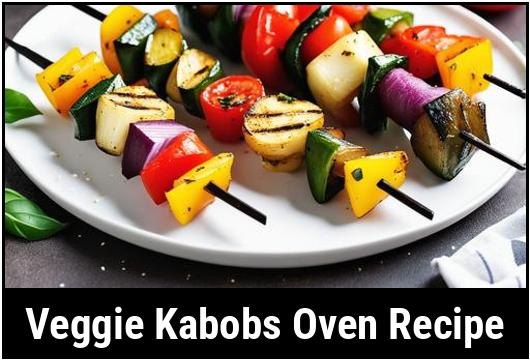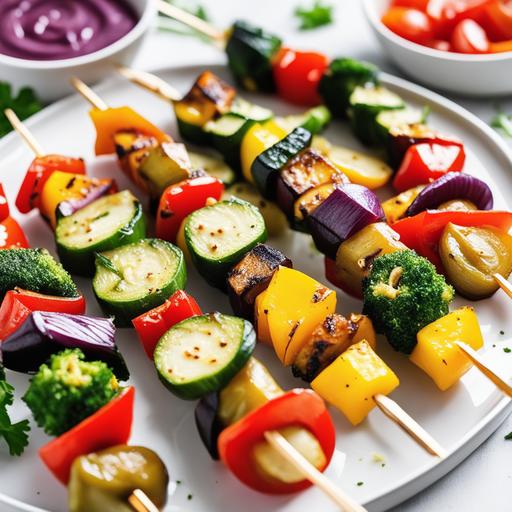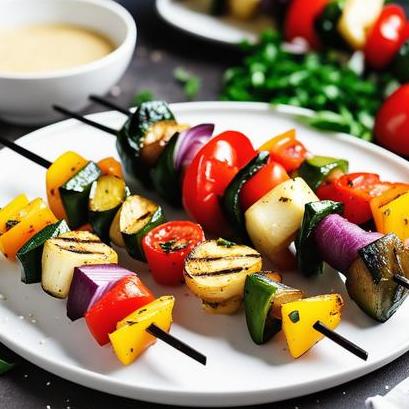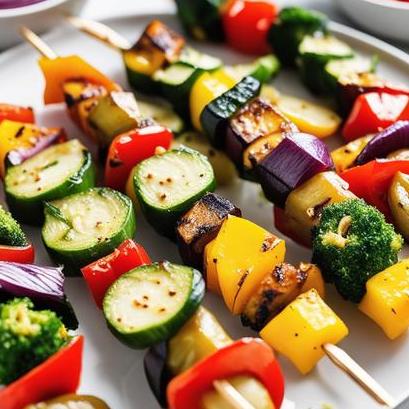
Veggie Kabobs Oven Recipe: A Comprehensive Guide
Veggie kabobs are a delectable and nutritious dish that is perfect for those looking for a flavorful vegetarian or vegan meal. These succulent vegetable skewers, cooked to perfection in the oven, boast a rainbow of vibrant colors, enticing aromas, and a delightful medley of flavors. In this comprehensive guide, we will explore the fascinating food science behind veggie kabobs, delve into various culinary details, discuss key steps in selection, cleaning, and preparation, provide practical tips and variations, as well as suggest ways to ensure doneness. So, let’s dive right in!
Food Science of Veggie Kabobs
At its core, veggie kabobs are a product of culinary science that combines various vegetables to create a harmonious blend of flavors and textures. Understanding the principles behind successful veggie kabob creation can greatly enhance your culinary skills.
Flavor Pairing
The flavor pairing in veggie kabobs is essential in creating a mouthwatering experience. Intentionally combining vegetables with complementary and contrasting flavors ensures a well-balanced taste. For example, pairing sweet bell peppers with earthy mushrooms or tangy cherry tomatoes with savory zucchini can create a delightful contrast that tantalizes your taste buds.
Textural Harmony
Consider the textures of the vegetables you choose for your kabobs. By incorporating a combination of crisp vegetables like bell peppers and tender ones like zucchini, you can create a pleasing textural contrast in each bite. Texture plays a crucial role in the overall enjoyment of the dish and can elevate it to new heights.
Maillard Reaction
The Maillard reaction is a chemical process that occurs during cooking, resulting in the browning of the food’s surface and the development of complex flavors. To maximize the flavor of your veggie kabobs, ensure each vegetable has ample surface area exposed to the heat. This will promote the Maillard reaction, enhancing the taste and appearance of your dish.
Culinary Details
Now that we understand the food science behind veggie kabobs, it’s time to explore the crucial culinary details that contribute to achieving the perfect outcome.
Selection of Vegetables
When selecting vegetables for your kabobs, choose those that are firm, vibrant, and fresh. Opt for a diverse range of vegetables to create a visually appealing and flavorful skewer. Some popular choices include:
-
Bell peppers
-
Cherry tomatoes
-
Zucchini
-
Red onions
-
Mushrooms
-
Eggplant
-
Sweet potatoes
Feel free to experiment with different vegetables based on personal preferences and availability. The key is to ensure a variety of colors, textures, and flavors on your kabob skewers.
Cleaning and Preparation
Before assembling your veggie kabobs, it’s essential to clean and prepare the vegetables properly.
-
Start by rinsing all the vegetables under cool running water.
-
Use a clean vegetable brush to scrub off any dirt or debris.
-
For bell peppers and eggplants, remove the stem and core, then slice into evenly-sized pieces.
-
If using cherry tomatoes, keep them whole.
-
Zucchini and sweet potatoes can be sliced into rounds or cubed for skewering.
-
Mushrooms may require wiping clean with a damp cloth instead of rinsing to avoid saturation.
Skewering Techniques
The way you assemble your veggie kabobs can influence both the cooking process and the final presentation.
-
Soak wooden skewers in water for approximately 30 minutes before assembling. This prevents them from burning in the oven.
-
Start by threading the vegetables onto the skewers, alternating colors and textures for an aesthetically pleasing arrangement.
-
Leave a small space between each piece to promote even cooking.
-
Ensure the skewers are not overloaded to allow for consistent heat distribution.
Seasoning and Marinades
Seasoning and marinades can elevate the flavors of your veggie kabobs. Consider these options:
-
Olive oil, garlic, and a sprinkle of dried herbs such as thyme or oregano.
-
A tangy marinade combining lemon juice, soy sauce, and a touch of honey.
-
Balsamic vinegar paired with Dijon mustard and minced herbs.
Allow your veggie kabobs to marinate for at least 30 minutes prior to cooking. This enhances flavor absorption and tenderizes the vegetables.
Tips for Success

Achieving excellent veggie kabobs requires attention to detail. Here are some tips to ensure a successful outcome:
-
Uniformity: Cut vegetables into similar sizes to ensure even cooking. This also improves the final presentation of your kabobs.
-
Preheating: Preheat your oven to around 400°F (200°C) to create the optimal cooking environment.
-
Basting: While cooking, occasionally baste your kabobs with the marinade or olive oil mixture to keep them moist and infuse additional flavors.
-
Broiling: To achieve a charred and slightly caramelized surface, switch your oven setting to broil for the last few minutes of cooking time.
-
Resting: Allow your cooked veggie kabobs to rest for a few minutes before serving. This enhances their flavors and tenderness.
Variations and Customizations

Veggie kabobs are highly versatile and offer numerous customization options. Let your creativity shine by incorporating different vegetables, seasoning profiles, and even protein alternatives like tofu or seitan. Consider these variations:
-
Asian-inspired: Marinate your vegetables in soy sauce, sesame oil, and ginger, and serve with a side of peanut sauce for dipping.
-
Mediterranean twist: Use fresh herbs like rosemary, thyme, and oregano along with a squeeze of lemon juice for a burst of Mediterranean flavors.
-
Protein-packed: Add cubes of marinated tofu or seitan to your kabob skewers for a heartier meal option.
Feel free to experiment with different combinations to find your personal favorite.
Doneness Checks

To ensure your veggie kabobs are cooked to perfection, follow these checks:
-
Pierce test: Insert a fork into the vegetables. If there is little resistance, they are likely cooked through.
-
Color and texture: The vegetables should have vibrant colors and a tender yet crisp texture.
-
Charring: Look for a slight char on the surface of the vegetables, indicating the desired caramelization.
The Veggie Kabobs Oven Recipe

Now that you have a good understanding of the various aspects of veggie kabobs, let’s dive into a delicious and easy-to-follow recipe.
Ingredients:
-
2 bell peppers (red, yellow, or green)
-
1 zucchini
-
1 red onion
-
8 cherry tomatoes
-
8 mushrooms
-
2 tablespoons olive oil
-
2 cloves of garlic, minced
-
1 teaspoon dried mixed herbs (such as thyme, oregano, or rosemary)
-
Salt and pepper to taste
Instructions:
-
Preheat your oven to 400°F (200°C).
-
Soak the wooden skewers in water for 30 minutes to prevent burning.
-
Prepare the vegetables by washing them thoroughly and cutting them into similar-sized pieces.
-
In a small bowl, combine the olive oil, minced garlic, dried mixed herbs, salt, and pepper.
-
Thread the vegetables onto the skewers, alternating colors and textures for an appealing arrangement.
-
Place the skewers on a baking sheet lined with parchment paper.
-
Brush the vegetable skewers generously with the olive oil mixture.
-
Bake the veggie kabobs in the preheated oven for approximately 15-20 minutes, turning them halfway through cooking. Keep an eye on them to prevent burning.
-
If desired, switch your oven setting to broil for the last 2-3 minutes to achieve a charred surface.
-
Remove the skewers from the oven and allow them to rest for a few minutes before serving.
Serving Suggestions:
Serve your veggie kabobs as a standalone meal or alongside a bed of fluffy couscous, quinoa, or a green salad. They can also be paired with various dipping sauces such as tzatziki, hummus, or sweet chili sauce for added enjoyment.
Conclusion
Veggie kabobs, cooked to perfection in the oven, present a delightful culinary adventure. By understanding the food science, selecting quality vegetables, following proper cleaning, and preparation techniques, and leveraging creative variations, you can create a stunning and flavorful dish. Remember to experiment, have fun, and enjoy the wonderful world of veggie kabobs!
Sources
FAQS On Veggie Kabobs Oven Recipe
What Ingredients Do I Need For A Veggie Kabobs Oven Recipe?
Ingredients needed for a veggie kabobs oven recipe typically include a variety of vegetables such as bell peppers, onions, zucchini, mushrooms, and cherry tomatoes, as well as a marinade of your choice. You will also need skewers to assemble the kabobs on.
Do I Need To Marinate The Vegetables Before Cooking Them In The Oven?
It is recommended to marinate the vegetables for at least 30 minutes before cooking them in the oven. This will help enhance the flavors and ensure even cooking.
How Long Should I Cook Veggie Kabobs In The Oven?
The cooking time for veggie kabobs in the oven can vary depending on the type of vegetables used and the size of the kabobs. Generally, it takes about 15-20 minutes at a temperature of 375-400°F.
Can I Use Frozen Vegetables For Veggie Kabobs In The Oven?
Yes, you can use frozen vegetables for kabobs, but it is recommended to thaw them first before marinating and cooking in the oven. This will help prevent the vegetables from becoming too watery and ensure even cooking.
What Type Of Marinade Is Best For Veggie Kabobs In The Oven?
The type of marinade you use for your veggie kabobs will depend on personal preference. You can use store-bought marinades or make your own using a combination of oil, vinegar or citrus juice, herbs, and spices. Just make sure to coat the vegetables evenly before cooking.



